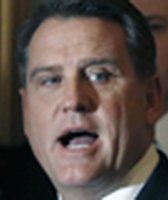Stand up for the facts!
Our only agenda is to publish the truth so you can be an informed participant in democracy.
We need your help.
I would like to contribute

Democrat Time Kaine, left, and Republican George Allen sometimes use accurate numbers to draw questionable conclusions.
As Election Day draws near, we’re finding plenty of political claims that sound earth-shattering but, upon examination, really aren’t.
They usually take a follow a formula: The candidate isolates a fact or figure to make a dubious point. Because the statement has literal accuracy; the campaigns say they should be rated True. The campaigns are seldom happy when we downgrade these comments for lacking context.
Sometimes we look into the statements and find that they don’t prove or disprove anything. So rather than put them to the Truth-O-Meter, we feel a quick explanation of our findings will suffice.
Here’s a few recent examples of those statements:
Kaine on health care premiums
During a Sept. 20 debate, Tim Kaine, the Democrat U.S. Senate candidate, said "health insurance premiums went up by over 60 percent" when Republican George Allen was in the Senate from January 2001 to January 2007.
Kaine’s numbers come from the Henry J. Kaiser Family Foundation, a private foundation that compiles an annual survey of employer health benefits. His campaign pointed to figures in this year’s report that shows that the average premium for employer-sponsored family health coverage rose from $6,438 in 2000 and rose to $11,480 by 2006. That’s a 78 percent increase -- even higher than rise Kaine cited during the debate.
The chart shows the average annual premium for a single person rose from $2,471 in 2000 to $4,242 in 2006 -- an increase of 71 percent.
Adjusted for inflation, family premiums increased by 52 percent during Allen’s term and policy costs for a single person rose 47 percent.
But health insurance analysts we spoke with were dismissive of Kaine’s effort to pin rising premium costs on Allen.The biggest driver of premiums is the underlying costs for health care services, said Alwyn Cassil, spokeswoman for the Center for Studying Health System Change, a health policy organization.
Cassil noted that in the late 1990s and the early 2000s there was a shift from Health Management Organizations to insurance plans that were less restrictive on the medical services patients could receive. As a result, people used more services, which helped lead to higher premiums, she said. Medical providers also raised prices for services, she said.
"Premiums went up, but the idea that one person is responsible for those things -- that’s boiling things down to the point of meaninglessness," Cassil said.
Allen on job creation
George Allen has been saying that his jobs record as governor tops Kaine’s record as governor.
"Over 300,000 net new jobs were being created in Virginia during my four years as governor as opposed to 100,000 jobs being lost (under Kaine)," Allen said in a Oct. 8 debate.
In February, 1994, Allen’s first full month as governor, there were 2,952,300 jobs in Virginia, according to the Bureau of Labor Statistics. When Allen left office in January 1998, there were 3,259,100 jobs -- an increase of 306,800.
In February 2006, Kaine’s first full month as governor, there were 3,713,500 jobs. That fell to 3,614,300 when Kaine left office in January 2010 -- a loss of 99,200 jobs.
But a comparison of Allen and Kaine’s raw job numbers doesn’t tell us much. Allen was governor during a strong nation economy. Kaine, in contrast, spent the final two years of his term battling the worst national recession in 70 years.
In addition, economists have repeatedly told us that governors have a limited impact on their state economies. Governors typically get too much credit for the good times and too much blame for the bad times.
Democratic Senatorial Campaign Committee ad
The DSCC is airing a TV ad that starts, "700,000 jobs -- that’s what the plan George Allen supports would cost our economy."
The DSCC bases that charge on Allen’s support for the 2011 Republican Cut, Cap and Balance plan, which called for substantial reductions in federal spending as well as spending caps and a balanced budget amendment. The DSCC pointed cites a July 2011 report from the liberal Center on Budget and Policy Priorities that estimated the plan would cost 700,000 jobs.
The calculation was based on the assumption that the plan would go into effect in 2012 and projections of how much the cuts would take out of the nation’s gross domestic product. Republicans, for their part, maintained the measure would lower the deficit and create an environment for job creation.
We couldn’t locate other estimates of projected job loss that would allow us to make a definitive ruling on this one. So we didn’t submit this to the Truth-O-Meter.
PolitiFact note
Democrat Paul Hirschbiel, who is seeking to oust Rep. Scott Rigell, R-2nd, recently cited PolitiFact Virginia while attacking Rigell.
"Virginia papers called Rigell’s campaign ‘Mostly False,' filled with personal attacks," Hirschbiel’s campaign said in a recent ad.
The ad shows the PolitiFact logo and cites a PolitiFact Virginia article from Oct. 25, 2010 -- during Rigell’s previous campaign in which he ousted Democratic Rep. Glenn Nye. Since Hirschbiel is channelling PolitiFact to try to score some points, we decided to offer a bit of clarity.
PolitiFact Virginia did not offer a sweeping judgement on Rigell’s campaign overall ability to tell the truth -- either back in 2010 or now. In fact, we haven’t reviewed any comments by Rigell this fall.
The article cited in the ad focused on Rigell’s 2010 claim that Nye "voted in lockstep" with former House Speaker Nancy Pelosi 83 percent of the time.
That one claim was ruled Mostly False because Nye voted with his party 82 percent of the time, he only voted with Pelosi on 66 percent of the votes, according to a Washington Post voting database. Nye was also one of the more independent Democrats voting with his party at a lower rate than most other Democrats.
Our Sources
Kaine for Virginia,"Fairfax Chamber of Commercer/NBC4 debate," Sept. 20, 2012. (Statement is at 28:25 in the video)
Kaine for Virginia,"Fact Check: Allen knows a thing about skyrocketing health care premiums," Sept. 20, 2012.
E-mail from Brandi Hoffine, spokeswoman for the Kaine campaign, Sept. 27, 2012.
Kaiser Family Foundation,"2012 employer health benefits survey," Sept. 11, 2012.
Bureau of Labor Statisticsinflation calculator, accessed Sept 21, 2012.
Interviews with Alwyn Cassil, spokeswoman for the Center for Studying Health System Change, Sept. 21 and 28, 2012.
Democratic Senatorial Campaign Committee, "George Allen’s ‘economically destructive policies would cost 700,000 jobs," Oct. 15, 2012.
Democratic Senatorial Campaign Committee, "George Allen’s ‘economically destructive’ policies would cost 700,000 jobs," Oct. 15, 2012.
Center on Budget and Policy Priorities, "Statement of Robert Greenstein on the ‘Cut, Cap and Balance Act’ that the House will consider on July 19," July 16, 2011.
George Allen for Senate,"Cut, Cap and Balance pledge," June 20, 2011.
Reuters, "Would the GOP’s ‘Cut, Cap and Balance’ plan really cost 700,000 jobs?" July 18, 2011.
Hirschbiel for Congress, "A better way," Sept. 28, 2012.
PolitiFact Virginia, "Scott Rigell says Glenn Nye voted ‘in lockstep’ with Nancy Pelosi 83 percent of the time," Oct. 25, 2010.
C-Span, "Virginia Senate Debate," Oct. 8, 2012.
Bureau of Labor Statistics, "State and area employment, hours and earnings," accesssed Oct. 16, 2012.











































